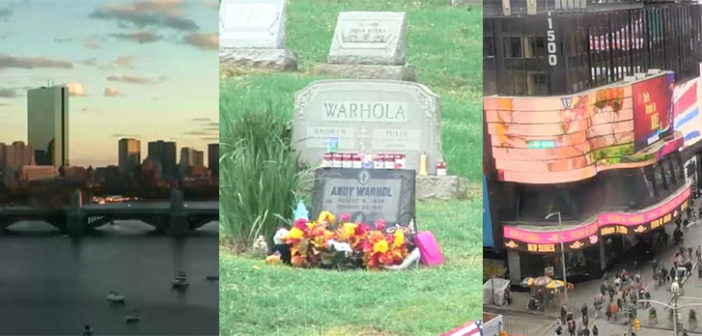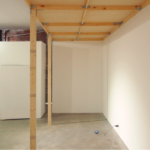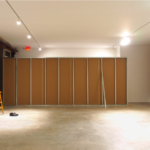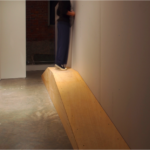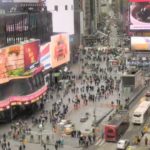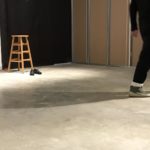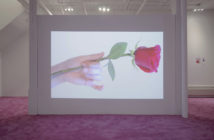Liao Fei’s exhibition at Yve Yang gallery at first glance seems to be a work in progress: perhaps even a transition between shows. Remarking on surveillance culture, Fei’s quiet exhibition not only gives visitors the uneasy feeling of being watched, but also questions tacit social acceptance of the constant government monitoring in public and private spaces. Fei altered the physical space of the gallery, constructing a wall and ramp near the entrance, as well as adding an overhang near the back of the gallery. Upon entering, the gallery appears nearly empty- except for several tablets in the entrance wall which feature live footage of Boston’s video surveillance monitors.
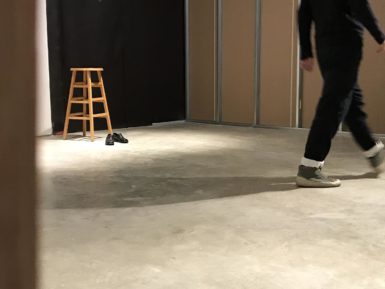
Perspective Installation, Liao Fei, 2016, Wood stool and shoes.
One display shows footage of the Charles River, another of the street outside the gallery. In main room, the only apparent installation is a stool with shoes at its base. Echoing the apparent emptiness of the room, the shoes appear to be left behind, the stool functional but unused. Eerily, the viewer discovers that instead of a private room under construction, there are hidden cameras filming live footage of the gallery space which can be viewed at all times on the gallery’s website. In the corner under the overhang, a phone is plugged into the wall. Again, at first glance, this appears to be a discarded personal item, not part of the exhibition. Upon closer inspection, the phone displays a live map tracking the artist’s location at all times. The exhibition features constructed ramps, hallways, and divisions. Aptly named Perspective, it asks the viewer to become cognizant of their own point of view. The visitor is invited to become a voyeur by peering, climbing, and peeping- all the time imagining the missing person who sat in the stool and left their shoes behind. Adding a level of surveillance to the show has the effect of taking the viewer out of their own experience. After realizing that they are being recorded, the viewer’s perspective changes, as they realize that they too are part of the exhibition. Layers of complexity, self- awareness, perception, and projection can be examined here. The artist himself seems to do away with the anxiety of constant surveillance by beating the government and the onlookers to it- he volunteers to have a live map tracking his whereabouts at all times. When I visited he was still on the map, back in Shanghai. It was 2 in the morning and he was sleeping.
In an era where constant surveillance has come to be expected, especially in public spaces, citizens are becoming more accustomed to the feeling of being filmed and watched. As public and private surveillance increases, many peoples’ feeling of unease is slowly being numbed. Liao Fei submits to supervision and unabashedly explores its components: the feelings of distress and passive acceptance, as well as the failure of surveillance to accurately capture the unique human perspective. He frankly shows us the unremarkable footage of Boston’s monitors alongside his own existence- debased to a pin on a map. What is being captured is incomplete- it cannot capture the breadth of human experience that each person being monitored is experiencing. His creation of distinct physical perspectives for the show recalls how the lived experience is so much more dimensional than what can be recorded.
- Constructed Space and Phone with Live Map of Artist’s Location, Liao Fei, 2016, iPhone, Google Maps.
- Constructed Perspective 2, Liao Fei, 2016, Panel and enforcement.
- Constructed Perspective, Liao Fei, 2016, Compression board, nails, blocks.
- Live feed of Andy Warhol’s grave, Liao Fei, 2016, Earth Cam footage used in Perspective installation.
- Live feed of the Charles River, Liao Fei, 2016, Earth Cam footage used in Perspective installation.
- Live feed of Times Square, Liao Fei, 2016, Earth Cam footage used in Perspective installation.
- Perspective Installation, Liao Fei, 2016, Wood stool and shoes.
Perspective, an installation by Liao Fei, was on view at Yve Yang Gallery through November 18, 2016.
Below are links to video footage used in the installation:

